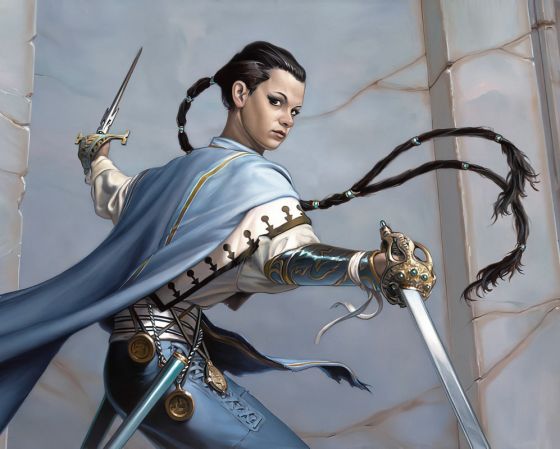Attacks with Two Weapons
Attacking with two weapons is an option for characters with a dexterity exceeding 12. Both weapons must be light enough to wield with one hand, with the off-hand weapon not exceeding 3½ lbs. in weight. Attacks made with the weapons each require 2 action points (AP) — so that striking twice in one round requires a total of 4 AP.
Naturally this means that combatants wishing to "dual-wield" must be lightly encumbered. One option is to use the fist as a secondary weapon, as striking with the fist requires only 1 AP. Better still, the fist need not be drawn or sheathed, so that it can be used spontaneously one round and then not the next. The drawback is that a character with little strength is unlikely to cause much damage with it.
| Dexterity | Penalty to Weapon | |
|---|---|---|
| Primary | Secondary | |
| 12 or less | ineligible | |
| 13-15 | -2 | -4 |
| 16 | -1 | -3 |
| 17 | -1 | -2 |
| 18 | 0 | -2 |
| 19 | 0 | -1 |
Penalties
When describing the two weapons, the "primary" weapon is the heavier, main weapon of the character, while the off-hand weapon is called the "secondary." With most combatants, both weapons are assigned certain penalties.
As the table shown indicates, the penalties against characters with a less than 16 dexterity greatly reduces the practicality of this approach. However, with characters who obtain a THAC0 of 16 or better, the penalties when fighting a number of lesser enemies become immaterial compared to the potential of damage done and kills made.
Characters with a 17 or 18 dexterity should consider the practicality of two weapons from the start, however. With little or no penalty accruing to the main weapon, the secondary attack is far more beneficial than no attack at all. Additionally, there are numerous benefits from the study of puissance that contribute to this attack strategy.
Benefits from Multiple Attacks
| # Attacks/ Round | Order of attack routine | |||
|---|---|---|---|---|
| 1st round | 2nd round | 3rd round | 4th round | |
| 5/4 | primary/secondary | primary/secondary | primary/2x secondary | 2x primary/secondary |
| 4/3 | primary/secondary | primary/2x secondary | 2x primary/secondary | |
| 3/2 | primary/2x secondary | 2x primary/secondary | ||
| 5/3 | primary/2x secondary | 2x primary/secondary | 2x primary/2x secondary | |
Characters who receive multiple attacks per round due to their experience can benefit considerably from attacks with two weapons. As fighter-types increase from one normal attack per round, extra attacks are received for both primary and secondary weapons. The order of benefit is given on the table shown.
The character must keep track of which point in the routine comes the next attack. So long as an attack was made in the preceding round, the next combination is applied, regardless of how many attacks were previously made.
- For example, Thomas is dual-wielding with three attacks every two rounds. In the 2nd round, he succeeded in killing his only opponent with the sword hit, and didn't need to use his secondary weapon twice; instead, he moved across the field of combat and engaged a new enemy. Now in the 3rd round, he's still entitled to his double primary weapon attack and his secondary attack.
- Contrariwise, in the battle, if he hadn't made his 2nd round routine attack at all, he'd still receive that 2nd round with his next attack, wherever that might happen.
As with all multiple attacks, whenever a given weapon attack is done twice, those attacks require 1 action point to resolve. In the example above, if Thomas were to attack in the second round with his primary weapon and only one secondary weapon, this would cost 2 AP for the primary attack and 1 AP for the secondary.
See also,
Attacking in Combat
Grazioso
Haste (spell)
